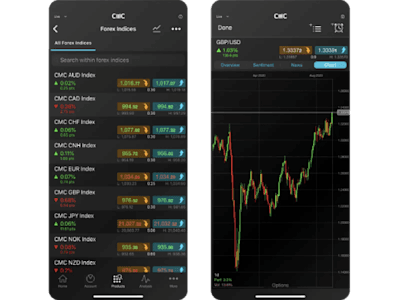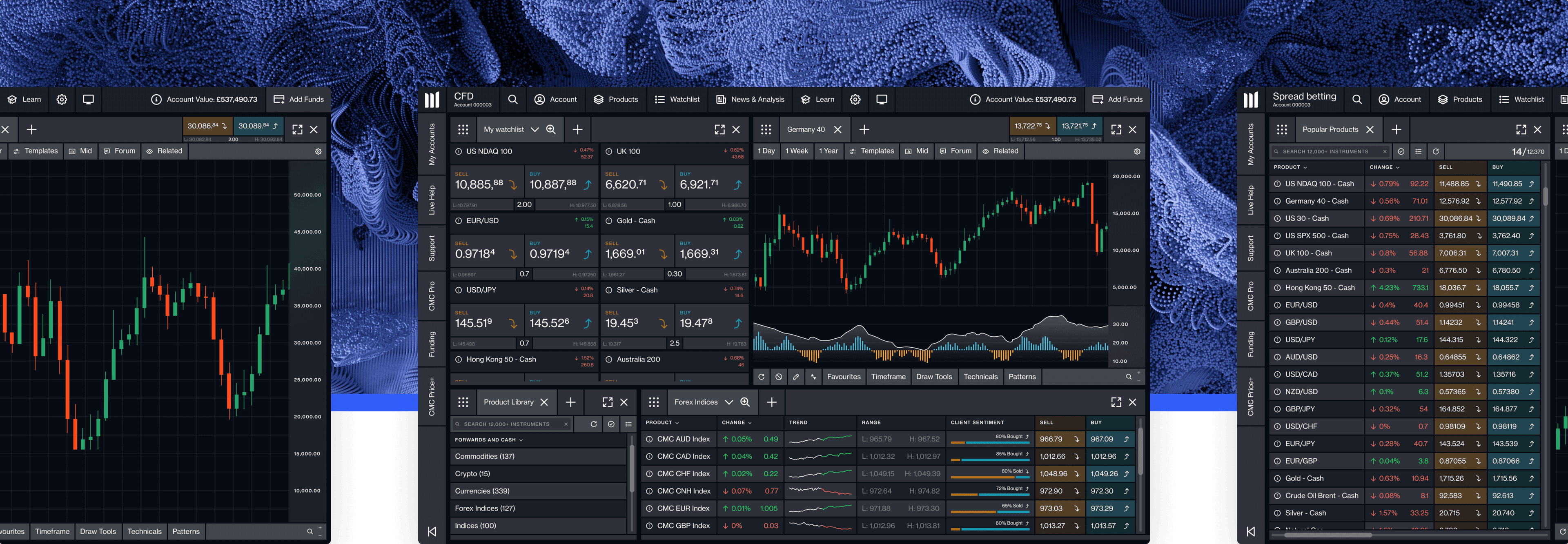What is spread betting and how does it work?
Spread betting is a popular form of derivative trading that enables you to speculate on the price movements of financial assets, such as indices, forex, commodities, and shares, without owning the underlying asset. Learn everything you need to know about spread betting and understand how it works.
What is spread betting?
Spread betting is a popular form of derivative trading that lets you speculate on the price movements of financial assets, such as indices, forex, commodities, and shares, without owning the underlying asset. Instead, you speculate on the direction you think the price of the instrument will move. You can trade on both sides of the market by going long (‘buy’) or short (‘sell’), depending on your view.
How does spread betting work?
When spread betting on the financial markets, you don't buy or sell the underlying instrument (for example, a physical share or raw material). Instead, you place a bet on a derivative, which tracks the value of that asset's underlying market price based on whether you expect the underlying market price to go up or down.
To help understand how spread betting works, go over the fundamental features of spread betting:
Leverage and margin
The stake
The spread
The bet size
The bet duration
Long and short trading
Leverage and margin
Financial spread betting is a margin based leveraged product. This allows you to get full exposure to the market without having to pay the total underlying market cost upfront. Instead, you only need to deposit a percentage to open a position.
The initial deposit of funds required to open a position in spread betting is known as the margin. Our margin rates for indices start at 5%. This means that you only have to deposit 5% of the trade’s full value to open a position.
This is equivalent to a leverage ratio of 20:1 (100/5=20) which is the leverage corresponding to a 5% margin rate. Trading with leverage magnifies your returns and losses.
If the price of the instrument you spread bet on rises, the margin required will increase; if it falls, the margin required will decrease. If you start to incur losses, your account value will decrease and, at some stage, may no longer be sufficient to cover your margin requirements (i.e., the margin you need to keep your current position/s open). Should this happen, you are at risk of a close-out, also known as liquidation. Read more about margin here.
The exact margin rate varies depending on the asset class and specific instrument being traded. Our margin rates range from 3.34% of the trade size on major currency pairs to 20% for shares, share baskets, and ETFs.
What is a stake?
In spread betting, the "stake" refers to the amount of money a trader is willing to risk per point of movement in the price of the underlying asset. The 'point' refers to a unit of change in the price of the asset.
For every point that the price of the instrument moves in your favour, you will gain multiples of your stake times the number of points by which the instrument price has moved.
For example, if you bet £1 per point on the FTSE 100 and it moves by 100 points from 7’450 to 7'550, you would profit £100 (£1 x 100 points).On the other hand, you will lose multiples of your stake for every point the price moves against you. Please note that profits or losses are based on the full notional value of the position, so you may lose more than the initial margin required to open the trade.
Conversely, if the FTSE 100 moves 100 points against you, you’ll be at a loss of £100.
The minimum stake for indices, forex, and commodities is £0.10 per point. The bigger the stake, the greater your exposure to the instrument and market you're trading. For instance, you would win or lose 10 times more with a £10 per point bet compared to a £1 per point bet.
What is the spread?
In trading, the difference between the buy (bid) price and the sell (ask) price is referred to as the spread. This is where a broker's commission is made, as the buy price will be slightly higher and the sell price slightly lower than the underlying market price.
Say, for example, that the FTSE 100 is trading at a buy (bid) price of 7450 and a sell (ask) price of 7452; the spread would be 2 points. If your stake is £10 per point, you would pay £20 in spread (2 points x £10 per point).
The spread is a key cost to consider. Spreads can change depending on a number of factors, including whether the underlying market is in our out of hours as well as trading volumes and liquidity, which in turn affect market volatility.
What is the bet duration?
Spread bets are typically short-term trades. Many spread betting instruments don’t have a fixed duration and can be closed at any time during the instrument’s trading hours. The type of trade is also a consideration when deciding the bet duration.
Spread bets on ‘cash’ instruments can normally be kept open for as long as you want to hold them¹. There is a daily overnight holding cost which you may pay or receive depending on the instrument you’re trading on and the direction of your bet.
Spread bets on ‘forward’ instruments have a set expiry date, at which the underlying futures contract expires. You can choose to roll your position to the following contract or settle your bet at the expiry of the contract. There are no daily holding costs incurred when spread betting on forward instruments; however, the spread is wider compared with the equivalent cash instrument.
Generally, it's more cost efficient for day traders to spread bet on cash instruments. On the other hand, for traders who are looking to keep a bet open for a longer period of time, it may be more cost efficient to spread bet on forward instruments.
It is important that you factor in costs and fees in your strategy, as they can affect your return.
Short and long trading
If you expect the price of an underlying asset to rise, you might open a long (buy) position, and if you think it will fall in value, you could take a short (sell) position.
If the market moves in your favour, you’ll make a profit, and if it goes against you, you’ll make a loss. You should also keep in mind that trading costs can affect your return. You can mitigate the risk involved by utilising risk-management tools.
Spread betting trade example
You anticipate that the FTSE 100 index will rise due to a positive economic forecast. You decide to place a buy spread bet on the FTSE 100 at £10 per point. (For simplicity, we’ve not included overnight holding costs or stop-loss orders.)
In our example, the FTSE 100 is trading at 7450 / 7452 (where 7450 is the sell price and 7452 is the buy price). The spread is 2 points.
Scenario 1: Winning bet
Your prediction is correct, and the index rises to 7520 / 7522. You decide to close your trade by selling at 7520 (the current sell price).
The price has moved 68 points (7520 sell price - 7452 initial buy price) in your favour. Multiply this by your stake of £10 to calculate your profit, which is £680.
Remember, other costs may impact your return, such as daily holding costs.
Scenario 2: Losing bet
Unfortunately, your prediction is incorrect – the market reacts negatively to a sudden economic downturn, and the FTSE 100 index drops over the next month to 7380 / 7382. You decide that the market is likely to continue falling, so to limit your losses, you decide to sell at 7380 (the current sell price) to close the bet.
The price has moved 72 points (7452–7380) against you. Multiply this by your stake of £10 to calculate your loss, which is £720.
Remember, your loss may be greater due to other costs, such as daily holding costs.
Considerations before you trade
Create a well-researched trading plan and stick to your strategy
Be aware of the macro environment, relevant economic data and company announcements
Test your ideas and strategies with virtual funds using a demo account
Use risk management tools available on our platform to mitigate your risk
Don't let emotions affect your trading strategy
Avoid recommendations and tips from unreliable sources, such as internet forums
Trading with leverage means any profit or loss you make is magnified. Financial markets can be volatile and major price changes happen overnight.
You risk losing the funds you’ve deposited, but as a retail client, you can’t lose more than the value of your account due to negative balance protection (this protection doesn’t apply to professional clients).
If your account balance is no longer sufficient to cover the margin required to keep your current positions open, your account might be subject to a close-out (liquidation).
Always monitor your positions carefully, and use appropriate risk-management tools.
There’s no minimum deposit amount to create an account with us. However, you won’t be able to place a trade until there are sufficient funds in your spread betting account to cover your margin. View our funding FAQs
As well as market orders, which open or close a trade at the current market price, limit and stop-entry orders allow you to specify a price level at which you want to trigger a trade. You can apply stop-loss orders to specify the price at which your position will be closed out, if the market should move against you. You can also set up take-profit orders, specifying a predetermined target level to secure a profit from your trades. Learn about spread betting execution types
You can offset potentially negative price movements by opening multiple positions on the same instrument.
Our platform requires clients to trade with leverage. However, the minimum margin rate is different depending on the market you’re trading. See our markets page for more information. We recommend making use of our risk management and execution tools when opening a position. Find out more about our spread betting demo account to practise trading on margin.
If you spread bet on shares, any dividends are automatically reflected in your spread bet. If you’re long on a company that declares a dividend, we’ll credit your account accordingly. But if you’re short, you pay the dividend and your account will be debited accordingly.
You can spread bet on more than 12,000 instruments through our award-winning platform and app. Our most popular markets include: indices, such as the UK 100, Germany 30, and US NDAQ 100; forex, including EUR/USD and GBP/USD; and commodities, like gold and natural gas. You can also speculate on thousands of global shares, over 1,000 ETFs, treasuries, and our exclusive forex indices and share baskets
2 Except in some circumstances which may be outside of our control.
Any questions?
Email us at clientmanagement@cmcmarkets.co.uk or call on +44 (0)20 7170 8200.
We're available whenever the markets are open, from Sunday night through to Friday night.




